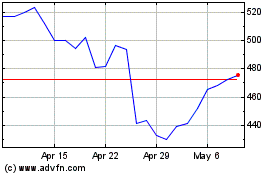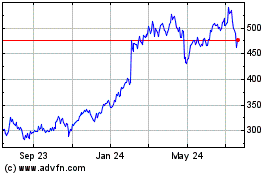Huawei Technologies Co. is already one of the world's top three
makers of telecom-networking gear and smartphones by market share.
Now, the Chinese technology giant is taking aim at the market for
cloud computing largely dominated by Western heavyweights.
Huawei is taking on Hewlett Packard Enterprise Co., Dell Inc.
and Cisco Systems Inc. in the supply of servers and other equipment
used in data centers, the key components of cloud computing, by
adopting the strategy it has used to expand in its smartphone and
telecommunications-equipment sales over the years: competitive
pricing and hefty investment in research and development.
"Undoubtedly, we will be a leader in this sector. We have the
capability," said Deputy Chairman Guo Ping in an interview, adding
that the company plans to spend at least $1 billion of its
research-and-development budget every year on equipment and
operating systems for data centers. Last year, Huwei's R&D
investment totaled roughly $9 billion.
Shenzhen-based Huawei, founded three decades ago by former
Chinese army engineer Ren Zhengfei, has little chance to expand in
the U.S., where its telecom equipment has been effectively banned
because of security concerns. Analysts say the Chinese company is
unlikely to become a supplier for Amazon.com Inc., Facebook Inc.
and Alphabet Inc., which build their own data centers to offer the
cloud services that enable businesses and consumers to access
applications and store information remotely.
But in Europe, Russia and Africa, where Huawei's wireless
networks are already being used, it is well-positioned to expand,
they say. Huawei's data-center clients include Deutsche Telekom AG
and Russia's central bank.
As more corporate clients become cautious about information
security, companies are building their own exclusive cloud
platforms and Huawei is trying to expand into that lucrative
segment to supply highly customized equipment and software for
private data centers.
The move is yet another ambitious plan by the world's
third-largest smartphone vendor, which aims to surpass Apple Inc.
and Samsung Electronics Co. to become the market leader in five
years.
For Huawei, internet infrastructure is an extension of its
telecom-equipment business, as carriers build more data centers to
offer cloud storage and applications. Technologically, there is an
overlap between telecom and data-center equipment, the company
says.
Huawei competes globally with HPE, Cisco and China's Lenovo
Group Ltd. in equipment and with EMC Corp.'s VMware Inc. and
Microsoft Corp. in operating systems used in data centers. In
China, Huawei plays the role of a cloud-service provider similar to
Amazon.com.
Huawei posted revenue last year of 395 billion yuan ($59
billion), with roughly 60% coming from telecom equipment and 33%
from consumer products such as smartphones. The company doesn't
disclose its data-center-related sales, part of which is included
in its telecom-equipment revenue. It employs about 170,000 workers
world-wide, including nearly 80,000 R&D employees.
The number of researchers and engineers working on technologies
for data centers has increased sharply to 16,000 this year from
3,000 in 2012, Mr. Guo said. Huawei isn't only increasing its
R&D budget, but also beefing up its sales workforce
overseas.
Those efforts are starting to pay off. Overseas markets now
account for about 40% of Huawei's revenue from internet
infrastructure products and services, compared with 25% last year,
thanks to growth in Europe, Russia and Africa, Mr. Guo said.
The company generates nearly 60% of its total revenue outside
China, according to its 2015 figures.
Outside China, a challenge for Huawei will be building alliances
with business partners who have longstanding relationships with
Western equipment suppliers, said Chris Barnard, analyst at
research firm IDC.
"Huawei has to try harder than its competitors," Mr. Barnard
said, adding that the company still needs to prove itself in terms
of services and technical support.
To that end, Huawei has been trying to forge more international
partnerships.
Last week, Huawei invited 20,000 clients, business partners and
industry experts to a cloud-computing conference in Shanghai where
speakers included top executives from Intel Corp. and
business-software provider SAP SE.
"In terms of the technology used for cloud computing, Huawei
isn't behind its Western competitors," said Thomas Aschenbrenner,
sales and marketing director at T-Systems International GmbH, which
offers a cloud-computing platform using Huawei's technology.
T-Systems, a unit of Deutsche Telekom, also works with Cisco.
Some Huawei clients said part of the Chinese vendor's appeal is
its competitive pricing. Neither Huawei nor its clients disclose
any pricing information, but in the global market for servers, for
example, the company's presence so far is mainly in the low-end
segment. Huawei was the fourth-largest server vendor by shipments
in the first quarter. But based on revenue, it wasn't among the
top-five vendors, according to research firm Gartner.
Still, Mr. Guo said customers who buy Huawei's low-end gear will
eventually let the company be the main builder of their private
cloud-computing platforms.
In China, Huawei is already a major supplier of data-center
equipment, helped in part by challenges facing foreign competitors.
Chinese government agencies have increasingly shifted toward
homegrown technology suppliers because of national-security
concerns.
Huawei's domestic clients include China Merchants Bank Co. and
local television broadcasters.
But in the U.S. data-center market, cybersecurity tensions
between Washington and Beijing are likely to severely limit
Huawei's prospects, analysts say.
Huawei acknowledges the challenges.
"We realize that the U.S. market is a stronghold for a lot of
other vendors," Mr. Guo said, adding that Huawei is still exploring
opportunities in the U.S.
Write to Juro Osawa at juro.osawa@wsj.com
(END) Dow Jones Newswires
September 11, 2016 21:15 ET (01:15 GMT)
Copyright (c) 2016 Dow Jones & Company, Inc.
Meta Platforms (NASDAQ:META)
Historical Stock Chart
From Mar 2024 to Apr 2024

Meta Platforms (NASDAQ:META)
Historical Stock Chart
From Apr 2023 to Apr 2024
